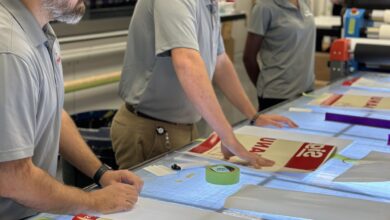Wraps go Back to the Future
Hard work, business savvy have helped get the industry to where it is today
The roots of vehicle graphics stem from what we know of as the hot rod industry. It was around the late 1950s when the first custom-painted (yes, I said painted) flame job appeared on a hot-rodded 1949 Mercury. The next significant shift pertaining to hot rod graphics and the decal industry wasn’t really until the 1990s when pressure-sensitive vinyl-AKA wraps-used to simulate paint on a vehicle landed on the scene, creating a major upheaval, revolutionizing the sign and automotive restyling industry in a way no one could have predicted.
Built with blood, sweat and tears, the wraps movement has now transcended automobiles to include walls, floors, concrete and even brick. Practitioners’ hard work and business savvy have helped get this industry to where it is today: a mature industry segment.
With so many opportunities springing up for commercial and specialty wraps, it is no surprise that entrepreneurs, sign shops and millennials alike are curious about how to get into this growing industry. As someone who has spent the last 17 years of my professional life supporting the growth and expansion of the wraps industry, I’m keenly interested in how increased competition and more opportunity in digital processes will affect us going forward-for both newcomers to the industry and experienced installers.
EDUCATION
Whether you are already installing vehicle wraps or are considering doing so, up-to-date certification training is an expected standard for the applicator in today’s commercial or specialty wraps world. However, not all training programs are created equal.
Until a time comes that an association or technical university offers wraps training as an accredited option, you will need to seek out individual companies that offer training. Your first course, with the right instructor, is often more valuable than many you take afterward. It’s important to do your homework and to find an experienced instructor with first-hand knowledge of the trade who also possesses a willingness to speak honestly about business and the mistakes they have made, so that you can avoid making the same ones. You should also make sure a first training course includes both business and digital training, detailed below.
Origins of Certification: The origins and current model for what we know as Certification & Training for Commercial Decal Application was born by the United Application Standards Group (UASG) and was followed up by the Professional Decal Application Alliance (PDAA). Today, there are many brands of application training with multi-leveled certification, which all of the material manufacturers offer at this time. Though it’s important to show your level of skill with documentation, the quality of the curriculum trumps all. There is so much information to be digested in a wraps training course, you will want to make absolutely sure your instructor is knowledgeable and experienced and has lived it.
Application Training: Most leading media manufacturers offer some type of application training course to teach newcomers wraps fundamentals, as well as more advanced applications. Ultimately, if you are just getting into the trade, whether focused on color change, digital prints or both, you’ll want to confirm whether portions of the training are outsourced, and whether the instructor has first-hand knowledge to back up the course content.
Business Training: A little more than a decade ago, a basic wrap class consisted of application training, design dos and don’ts, gates in production, materials-and last, but not least, business essentials. Today, many courses skip over the business elements and focus exclusively on installation technique with the unspoken idea that it will all be okay in the end. Make sure that the course you are considering covers more than just wraps installation. Do your research before writing that check. Get informed and educated by a qualified instructor that is living it every day.
Graphic Design: When you boil it all down, no matter what your direction, you’re always better off creating a picture that’s worth 1,000 words before the actual printing or ordering of materials. Your picture should be a mock-up of what the actual design would look like once on the car or object in question. It should have everything you and the client discussed. This will be the instrument that doesn’t lie. If you don’t possess the skills to produce this, either hire skilled professionals who do, or better yet, invest in yourself and your future by taking night courses to become proficient in Adobe Illustrator and Photoshop. The investments you make in yourself and your business today-in the form of money, time and skills-will come back tenfold later on.
DEVELOPING AND RUNNING THE BUSINESS
Written Contracts: What you believed you committed to and what the client believed they were entitled to receive can easily differ. Can you articulate what they are imagining even when they don’t know? It’s essential that wrap installers/providers protect themselves by coming to written agreements with their clients. Write it down in a way that the client can both understand and approve. If a client approaches you with a complaint or says, “That’s not what I paid for,” you want to have a binding document that describes what they approved. After all, in a court of law, whether you are right, wrong or otherwise, it’s all hearsay and you are the one writing the check, unless you have clear and legally-defendable contracts. When starting your business, you should hire a lawyer to review your terms, conditions and contract templates.
Know Your Media Warranties (You Are the Warrantor): This is one of the easiest areas to get yourself into trouble. With material manufacturers’ warranties so complex that often even we practitioners don’t fully understand what is and isn’t warrantable, you must find a way to clearly communicate to your client in layman’s terms what the media warranty covers. The only warranty that we, as a wrap shop, provide is a one-year warranty on workmanship if the wrap is installed on an OEM painted surface. If not an OEM painted surface, then no warranty.
Premium digital cast films (the most predominant media for vehicle wraps) are durable, but will experience a short life span with UV exposure. Therefore, we laminate the print with a 2-mm cast optically clear over-laminate, which can last up to five years on vertical surfaces, providing for five years of clean removability (5&5). If using a thinner 1.3-mm laminate, it’s (4&4). However, the horizontal surfaces are not always warrantable from the manufacturers, and life expectancies may be only a year or two depending upon how the client takes care of their graphics and where they live. Again, this is on OEM painted surfaces. If other than OEM painted surface, the product is not warrantable.
If you don’t convey this information in a way that the client can understand and the materials fail, they will likely fault you and not the manufacturer. What this really means is that you (the business owner) effectively become the warrantor if a failure occurs. Ask your material manufacturers to articulate the warranties for you so that you can in turn clearly communicate these details to your customers. You will want to communicate this simplified version of the manufacturer’s warranty terms so that they understand that if they don’t take care of the wrap, it will degrade in less time than the manufacturer has implied.
Appropriate pricing: How do you make money without pricing yourself out of the market or offering “low-ball” market killers? Bidding a typical commercial barrier project at one third of the going rate not only leaves money on the table but also weakens the industry as a whole. Low-balling may help you win a few jobs, but will never support the costs of running a brick and mortar shop that includes overhead, employee costs, certificate renewals, taxes, a fleet of trucks, equipment and maintenance – not to mention the trash bill, phone bill, certifications and so much more. Wake up, smell the coffee and do the math!
Shop Selection: Selecting the right space for your wraps business is critical. One fundamental question will be, “can you keep your shop dust free?” Is it even possible for your shop to be truly clean? Example: I have heard of situations where the entrepreneur rented a space and only after moving in, realized that the building next door was home to a part-time carpentry studio. Don’t let this be you and do your due diligence ahead of signing anything.
Versatile Equipment: As more people enter commercial or specialty wraps, overall profit margins will ultimately go down as competition increases. This is why it is so important for existing and new business owners to find ways to augment their businesses and find versatile uses for their equipment. If you run a print shop that specializes in point of purchase (P.O.P.) banners and flat surface applications, vehicle wraps could be a value-added component to your business. You likely already have the output capabilities. Likewise, color change specialists also should add digital print capabilities, as the future of color change is being diluted.
Make sure you have the right printer and equipment for the job. When it comes to wraps, our prints must stand the test of time (remember, you are the warrantor). Lucky for you, printing equipment has never been as affordable as it is now.
Pay Attention to the Details: In today’s digital world, with all the gates in production, mistakes made early on will raise their ugly heads down the road and cost you in ways you can’t imagine. Do it right the first time and force yourself to become detail-oriented. Double, triple and even quadruple check yourself. That “t” that didn’t get crossed in design and which nobody caught until it screams out on the side of a vehicle wrap will cost you dearly-in materials, ink, labor, extra time and in the form of a disappointed client. Your gut never lies. If something doesn’t feel right-investigate immediately.
Communication, Communication and Communication: Whether entering the market as a color change specialist, commercial digital application entrepreneur (or both), you’ll need to have a certain level of skill and confidence in conveying information to the client – whether it’s about materials, color, warranties or the lack thereof. Remember, you are the most knowledgeable party in the conversation. Being an effective communicator will demonstrate you know your stuff. This includes being a good listener, too. Good communication leads to using less labor and material, fewer mistakes and positive employees working toward a finish. The outcome is a happier, more profitable workplace, paving the way for employee loyalty. Be a good listener and back it up with a standardized contract. You will thank yourself, I promise.
Having watched the wraps industry from its infancy, the only constant I see is change. Learn from those who came before you and then be bold. Be smart and creative. The next wave of wraps advancement is upon us and I look forward to seeing how you contribute, innovate and change the industry-and take it to the next level.










